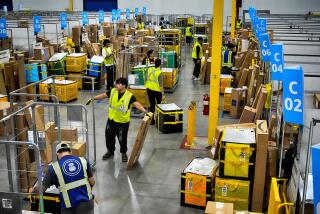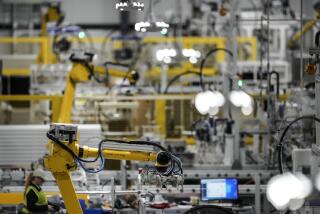Future Index Hints Cooling in Economy
WASHINGTON — The index of leading indicators, the government’s main barometer of future economic activity, rose modestly in August in a continuation of a seesaw pattern that points to a slowing rate of growth, the Commerce Department said today.
The index, which is designed to forecast economic growth six to 12 months from now, rose 0.4% in August after falling 0.6% in July. Before that the index rose 1.5% in June, fell 0.7% in May and rose 0.3% in April.
Economists said the pattern suggests the coming months will see slower growth than the robust 3.2% rate for the first half of 1988. The economy is now closing in on its sixth full year of uninterrupted expansion.
Index About to Peak
“This up-down, up-down is consistent with what you see when the index is about to peak,” said Donald Ratajczak, director of economic forecasting at Georgia State University. “I think it’s probably indicating more moderate growth ahead.”
With growth slowing to a rate that will help contain inflation at moderate levels, the economy is unlikely to give Democratic presidential candidate Michael S. Dukakis much ammunition against Republican candidate George Bush.
But regardless of the outcome of the November elections, most economists are predicting that the next President will preside over a country headed for a recession.
Recession Expected
In a recent survey by the National Assn. of Business Economists, nearly 90% of those polled said they expect a recession either next year or in 1990. Economists generally define a recession as six consecutive months of contraction.
In the 12 months leading up to August, the index rose only 0.9%, the smallest yearly gain since the country was in a recession six years ago, Commerce officials said.
“When you take it all together, what it suggests is a slowing rate of expansion,” said economist Cynthia Latta of Data Resources in Lexington, Mass.
Five of the nine economic indicators used in the August leading index were positive, the strongest of which was a decline in claims for unemployment benefits to 298,000 per week from 325,000 per week in July.
Factory Orders Up
Also contributing to the August rise in the index were stronger factory orders for consumer goods, higher spending by businesses on plant and equipment, and more building permits.
Three of the four negative indicators that went into the index in August were the average workweek, stock prices and the money supply, all of which declined.
In a separate report that economists said also pointed to an economic slowdown, the Commerce Department said the pace of sales of new single-family homes has stagnated since June.
But the seasonally adjusted 713,000-unit annual rate of home sales in August was still 5.9% above the rate of home sales a year earlier, it said.
More to Read
Inside the business of entertainment
The Wide Shot brings you news, analysis and insights on everything from streaming wars to production — and what it all means for the future.
You may occasionally receive promotional content from the Los Angeles Times.










